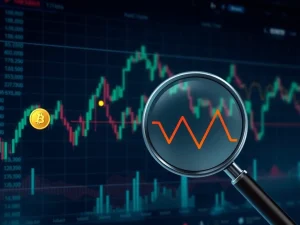Bitcoin Options Reveal Critical Market Caution: Is BTC Price Poised for Resilience?

The cryptocurrency market often sends mixed signals. Currently, Bitcoin (BTC) faces scrutiny. Recent data from **Bitcoin options** suggests increasing caution among traders. Many wonder if this signals an imminent **BTC price** collapse. However, a deeper analysis reveals a different story. This heightened demand for downside protection likely reflects broader **macro risks** rather than a direct bet against Bitcoin’s value. Understanding these **hedging strategies** is crucial. They might help BTC avoid a significant drop towards $110,000.
Bitcoin Options: Unveiling Market Caution
Bitcoin’s inability to reclaim the $115,500 mark has drawn attention. This coincided with a noticeable increase in demand for downside protection. Traders are using BTC options for this purpose. Bitcoin bears could potentially push the **BTC price** below $112,000. This move may reflect global trade war uncertainty. Cryptocurrency traders generally maintain an optimistic outlook. Therefore, demand for put (sell) options is typically lower. It is usually about 50% less than for equivalent call (buy) contracts.

The current 90% put-to-call ratio indicates growing interest. Traders are exploring neutral-to-bearish **hedging strategies**. Readings above 100% appeared on Friday and Saturday. These levels signal significant fear and are highly unusual. This surge in demand for downside protection has also driven put options. They now trade at a premium over call options. In healthy markets, the skew metric typically remains within a neutral -6% to +6% range. At +7%, the current reading marks the highest level in four months. This shows traders are willing to pay extra. They want to guard against negative price shocks. This specific **market caution** reflects underlying concerns.
Decoding BTC Price Signals: Hedging vs. Bearish Bets
While this data might seem bearish initially, it does not necessarily mean traders are betting on a direct **BTC price** decline. Hedging occurs for various reasons. Negative external pressures often drive this activity. Examples include import tariffs and concerns over excessive concentration in artificial intelligence (AI) bets. Nvidia (NVDA) and Microsoft (MSFT) are now the largest companies by market capitalization. These broader economic factors influence investor behavior. Therefore, understanding the context is vital.

Corporate earnings have also disappointed across various sectors. For instance, Caterpillar (CAT) projected potential $1.5 billion losses. These losses are tied to US import tariffs in 2025. Similarly, Saudi Aramco, the world’s largest oil producer, reported a 19% year-over-year drop in net profit. Lower global oil prices caused this decline. Kleenex tissue maker Kimberly Clark (KMB) also lowered its annual profit forecast. The company cited $300 million in expected costs from import tariffs. Heating, ventilation, and air conditioning specialist Carrier Global (CARR) cut its full-year outlook. United Parcel Service (UPS) reported a 3% revenue decline from the prior year. These examples highlight widespread **macro risks** impacting traditional markets. Consequently, investors seek protection in all asset classes, including crypto.
Macro Risks Drive Strategic Hedging in Bitcoin Markets
Even if AI demand remains strong into the second half of 2025, traders appear less willing to hold riskier assets. This trend emerges amid ongoing uncertainty in global markets. US Treasury Yields also signal increased risk aversion. Yields on the US 10-year Treasury fell to 4.21% on Tuesday. This was down from 4.32% a week earlier. This decline indicates investors are accepting lower returns. They prioritize the safety of government-issued bonds. This is a classic sign of heightened risk aversion. It further underscores the prevalence of **macro risks** affecting market sentiment.

To truly determine if Bitcoin traders are actively betting on a price crash, examining BTC monthly futures contracts is essential. Heavy demand for bearish positions would typically push the annualized premium below the 5% neutral threshold. However, this is not currently the case. The premium on BTC monthly futures remains comfortably within the neutral 5% to 10% range. It stands at 7%. This metric held steady even during Sunday’s $112,000 retest. This indicates resilience in the futures market. This resilience contrasts with the **market caution** seen in **Bitcoin options**.
Bitcoin Futures Premium: Assessing BTC Price Stability
The stable futures premium suggests professional traders are not positioning for a significant **BTC price** crash. Instead, their **hedging strategies** appear defensive. They aim to mitigate potential downside from broader economic headwinds. This is distinct from outright speculation on a price collapse. Therefore, while **Bitcoin options** indicate caution, they do not point to an imminent freefall. The market is adapting to global financial shifts. It is not necessarily signaling a fundamental weakness in Bitcoin itself. The focus remains on managing risk from external factors. This cautious approach helps maintain market stability.

Uncertainty in macroeconomic conditions remains the primary driver. This drives the elevated demand for downside protection via **Bitcoin options**. However, little evidence suggests professional traders are positioning for a Bitcoin price crash to $110,000. This analysis highlights a nuanced market perspective. Traders are being prudent. They are not panicking. This distinction is crucial for understanding current market dynamics. It implies a resilient underlying asset. This article provides general information. It is not legal or investment advice. The views expressed are the author’s alone. They do not represent Crypto News Insights.










